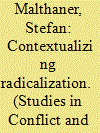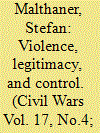|
|
|
Sort Order |
|
|
|
Items / Page
|
|
|
|
|
|
|
| Srl | Item |
| 1 |
ID:
133506


|
|
|
|
|
| Publication |
2014.
|
| Summary/Abstract |
This article proposes an analytical perspective on jihadist radicalization that focuses on the immediate social environment from which clandestine violent groups emerge, to which they remain socially and symbolically connected, and from which they receive some degree of support. Based on a detailed analysis of the "Sauerland-Group" it traces relational dynamics shaping individual pathways as well as processes of group formation within local Salafist milieus, the wider Salafist movement, and radical jihadist networks. It argues that one characteristic feature of "homegrown" jihadist groups is their simultaneous connection to and embeddedness in various different social contexts as well as the fluid, ad-hoc character of the clandestine group and its ambivalent relation with its supportive social environment
|
|
|
|
|
|
|
|
|
|
|
|
|
|
|
|
| 2 |
ID:
134987


|
|
|
|
|
| Summary/Abstract |
Terrorist groups are not completely isolated, socially “free-floating” entities, but emerge from and operate within a specific, immediate social environment—what we call the radical milieu—which shares their perspective and objectives, approves of certain forms of violence, and (at least to a certain extent) supports the violent group morally and logistically. In this article we introduce an approach to conceptualize and analyze this formative and supportive social environment of clandestine groups, addressing the questions of how the radical milieu emerges, what forms it takes, and what role it plays in shaping the development of violent groups. Our focus, thereby, rests on relationship-patterns between violent groups and radical milieus as well as on processes of interaction between radical milieus and their broader political and societal environment, which may entail dynamics of support and control but also isolation and radicalization
|
|
|
|
|
|
|
|
|
|
|
|
|
|
|
|
| 3 |
ID:
143539


|
|
|
|
|
| Summary/Abstract |
When police moved against a mosque known to be a stronghold of al-Jamaa al-Islamiyya (The Islamic Group) in a neighbourhood in northeastern Cairo in summer 1988, they quickly became involved in street battles in which they were confronted not only by members of the militant Islamist group but also by many ordinary residents, including teenagers and elderly women throwing stones from balconies. It was obvious that the group had built a considerable base of support in the area: ‘They were very good young people’, one resident explained. The Islamists ‘used to have very active social work around their mosque. […] They collected donations for needy families and intervened in family disputes;’ and people, as he recounted, ‘admired their bravery to voice something the government does not want’ (Interview with residents of Ayn Shams, Cairo, March 2005). Yet, the resistance proved short-lived. When the neighbourhood was put under a curfew after the riots, people gradually withdrew from the group and many young followers shaved and changed their white galabiyya for a pair of trousers.
|
|
|
|
|
|
|
|
|
|
|
|
|
|
|
|
|
|
|
|
|